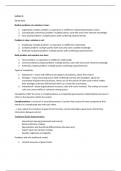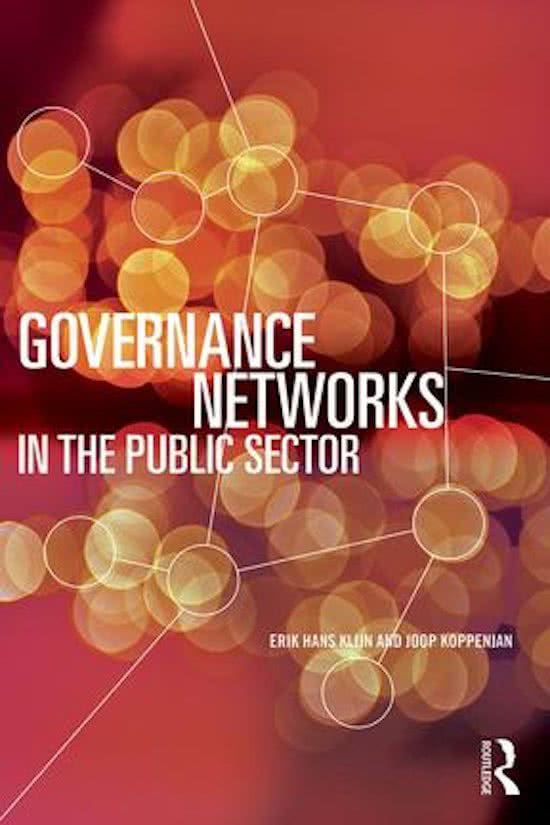Lecture 1.
04-09-2023
Neither problem nor solution is clear:
1. Cognitively complex problem: co-operative or indifferent relationship between actors
2. Conceptually contentious problem: multiple parties, each with only some relevant knowledge
3. Very wicked problem: multiple parties with conflicting values/interests
Problem is clear, solution is not:
1. Analytically complex problem: co-operative or indifferent relationship
2. Complex problem: multiple parties with each only some useable knowledge
3. Politically turbulent problem: multiple parties with conflicting values/interests
Both problem and solution are clear:
1. Tame problem: co-operative or indifferent relationship
2. Communicatively complex problem: multiple parties, each with only some relevant knowledge
3. Politically complex problem: multiple parties conflicting values/interests
Types of complexity:
1. Substantive = actors with different perceptions of problems, about the content
2. Strategic = many interacting actors with conflicting interests and strategies, about the
uncertainty of governance processes. Actors act on the actions of other actors which makes
their strategies unknown beforehand which can create this uncertainty.
3. Institutional = about organisational structure, rules and norms involved. The overlap of certain
rules can cause conflict or confusion among actors.
Complexity is NOT the same as complicatedness as complexity goes beyond complicatedness because it
refers to the dynamics within the system.
Complicatedness = technical or social phenomenon / system that consists of many components that
interact in a complicated way with each other.
--> learn about the transition of government (vertical, central-steering) to governance (horizontal,
interactions between actors)
Traditional Public Administration
- Hierarchical steering (command and control)
- Rational decision-making
- Specialisation and functional differentiation (bureaucracy)
- Expert input into decision-making
- Equality, legitimacy and legality
Problems with the traditional model:
1. Limited resources of government
, 2. Limited capacity of single actors to define problems and solutions
3. Not everyone agrees on what the problem is --> ill-defined problems
4. Uniform solutions in an increasingly pluralistic society
5. Imposing decisions invokes resistance
6. High implementation and monitoring costs
With TPA they are trying to solve wicked problems, with the help of a limited capacity of single actors.
These actors do not always agree on what the problem is which creates ill-defined problems. In order to
solve wicked problems, it is necessary for different branches in government to work together and
interact to come up with a suitable solution to complex problems.
New Public Management
- Response to TPA
- Running the government as a business
- Steering, not rowing (setting targets for outcomes, not involved in the implementation of those
goals)
- Market mechanisms; privatisation, competition and contracting
- At arm's length
- Performance management
Problems with NPM
- There is a high pressure to specify desired outcomes in advance
- Rigidity of contracts in changing circumstances (so not a lot of flexibility)
- Information asymmetry between principal and agent
- Competition between agents hampering learning
Important definitions:
1. Network governance = steering attempts of actors within networks aimed at influencing
processes and outcomes (negotiation and cooperation)
2. Governance networks = patterns of social relations between public, private and societal actors
involved in dealing with a problem policy or public service
3. Network management = conscious attempts at enhancing interaction between actors within a
network aimed at joint solutions and services
Network governance
- No central decision-maker but a network of interdependent actors
- No central goals, negotiations and power games
- Highly dynamic interaction processes
- A network can be very messy and difficult, thus guidance and facilitation are needed
There are several understandings of the term 'governance'
1. Good governance / corporate governance
--> emphasis on the operation rather than the manner in which it's organised
,--> adheres to principles of the rule of law
2. NPM (market governance)
--> steering, not rowing (setting goals, leaving implementation to other actors)
--> usage of performance management to measure results
3. Multilevel governance / intergovernmental governance
--> achieving results in a multi-actor environment
--> networks can address problems as they cross boundaries and hierarchical levels
4. Network governance
--> self-steering or non-self-steering
--> focus on the complex interaction process in a network of public, private and societal actors
Particularities and potential weaknesses of network governance:
1. Combines an institutional approach with an action perspective
2. Lack of attention to content of issues and debates
3. No specification on implications on the differences of the area that has focus
4. One-sided focus on effectiveness of governance network processes
In what respect does New Public Management oppose the notion of governance?
-->
Four misunderstandings about governance:
1. Governance is everywhere
The term often gets used in literature, but it is tended to be overused and not always used correctly.
2. Governance = NPM
NPM and governance are two different terms whereas Governance is focused on the interactions
between actors and horizontal relations, and NPM is mostly focused on vertical relations and the need
for central steering (government).
3. Governance is apolitical or technocratic (= relating to or characterized by the government or
control of society or industry by an elite of technical experts.)
Since governance is focused on the horizontal relationships, this also includes the relationship with
political actors. With the policy making process, there is always a form of politics involved which makes
governance inherently political.
4. Governance is composed of self-steering governing networks
, Self-governing processes often get blocked because of conflicting interests, perceptions, strategies or
institutional barriers. Therefore, it is not always possible to self-steer the governance networks, other
actors are involved in the process which can cause conflict or stagnations.
Common characteristics of network definitions:
1. Collective actions required
2. High interdependency
3. High degree of strategic complexity
4. Complex interactions due to autonomous actors
5. Durability over time
Objectives of three dominant perspectives in PA:
1. TPA: effective and uniform policies and services according to principles of equality legitimacy
and legality
2. NPM: improving effectiveness and efficiency of public delivery and public organisations
3. Governance network: improving interorganisational coordination and quality of policymaking
and service delivery
Effectiveness: producing a result that is wanted
Efficiency: producing the desired result without wasting resources, time or energy
Application lecture 1.
The term interdependent is used since actors can rarely solve problems all on their own. It is inspired by
the resource dependence theory; Actors form relationships to secure access to necessary resources.
Actors are similar to stakeholders as they can or can be affected by policies, problems or projects.
Resources: The range of formal and informal means that actors possess in order to achieve their
objectives
With a high-dependence, one can speak about a 'critical actor', where another actor needs to be
involved in order to reach a certain outcome.
Low importance & high substitutability = low dependency
Low importance & low substitutability = moderate dependency
High importance & high substitutability = moderate dependency
High importance & low substitutability = high dependency
type of analytical activity:
1. Actor analysis
- who are most important actors and what are their perceptions
- An actor can be an individual, group, organisation or coalition of organisation that can act
autonomously.
Steps – actor analysis






